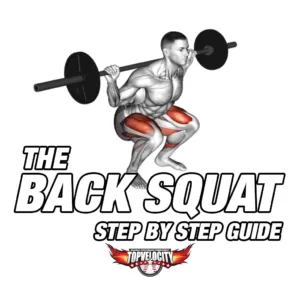 The back squat is a cornerstone exercise in strength and conditioning programs, revered for its comprehensive engagement of the lower body and core muscles. The "Ass to Grass" (ATG) technique takes this classic lift to new depths—literally. This guide will walk you through mastering the ATG back squat, ensuring you perform it with proper form and maximum effectiveness.
The back squat is a cornerstone exercise in strength and conditioning programs, revered for its comprehensive engagement of the lower body and core muscles. The "Ass to Grass" (ATG) technique takes this classic lift to new depths—literally. This guide will walk you through mastering the ATG back squat, ensuring you perform it with proper form and maximum effectiveness.
The ATG back squat is a variation of the traditional back squat where the lifter descends until the posterior touches the ankles. This full range of motion move is not just about strength; it's about mobility, stability, and power. It's a technique that can benefit athletes across all disciplines, especially those looking to enhance their performance on the baseball field.
Benefits of ATG Back Squats
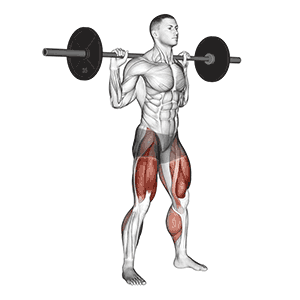
- Enhanced Leg Strength: ATG squats target your quadriceps, hamstrings, and glutes more intensely than partial squats.
- Improved Mobility: The full range of motion promotes flexibility in the hips, knees, and ankles.
- Increased Power: The ATG squat can lead to improvements in jump height and sprint speed, crucial for baseball players.
- Better Stability: The deep squat position challenges your core and stabilizer muscles.
Step-by-Step Technique for the Ass to Grass Back Squat
Starting Position:
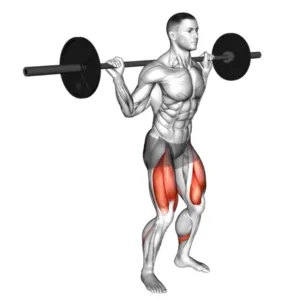
- Feet Placement: Position your feet shoulder-width apart. This stance may vary slightly depending on your body type and flexibility. The toes should be turned outwards at a slight angle, typically between 5 to 15 degrees, to allow for a natural range of motion.
- Barbell Positioning: For a high-bar squat, the barbell will rest on top of the traps, which is typically recommended for ATG squats due to the more upright torso position it encourages. For a low-bar squat, the bar is placed just below the spine of the scapula, resting between the traps and rear deltoids. This position is often preferred by powerlifters or those looking to maximize the amount of weight lifted.
- Grip: Grip the bar firmly with your hands just outside shoulder width. This grip can vary slightly wider or narrower based on comfort and shoulder mobility. Ensure your wrists are in a neutral position to avoid strain.
- Core and Chest: Brace your core as if you were about to be punched in the stomach; this increases intra-abdominal pressure, which supports the spine. Keep your chest up and shoulders back to maintain a strong upper back and to help prevent rounding of the spine during the squat.
Descent:
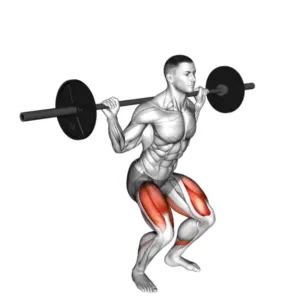
- Hip and Knee Hinge: Initiate the movement by simultaneously bending at the hips and knees. It's essential to sit back and down, not just straight down, as if you're lowering onto a chair. This helps in engaging the glutes and hamstrings effectively.
- Weight Distribution: Keep the weight distributed across the whole foot, but focus on keeping it slightly more towards the heels and mid-foot. This balance helps maintain stability and prevents you from tipping forward.
- Spine Alignment: As you lower yourself, it's crucial to maintain a neutral spine. Avoid rounding or overarching your back. Imagine a straight line running from your head through your tailbone.
- Depth: Continue to lower yourself until your hips are below your knees. This is the "ass to grass" position. Ensure that your knees are tracking over your toes and not caving inward.
Ascent:
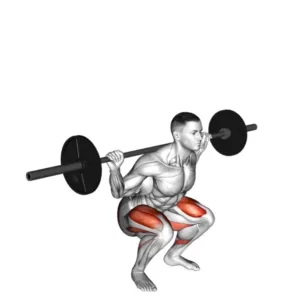
- Driving Up: To ascend, drive through your heels and mid-foot, pushing the floor away from you. Avoid the temptation to shift your weight onto your toes, which can lead to imbalance and undue stress on the knees.
- Hip and Knee Extension: Extend your hips and knees simultaneously. This coordinated movement is key to lifting the weight efficiently and with power.
- Upper Body Position: Keep your core braced, and maintain your chest and head in an upright position. This will help you maintain balance and ensure that the barbell travels in a vertical line.
- Completion: Continue to push upward until you return to the starting position, with your hips and knees fully extended.
Breathing:
- Inhale: Take a deep breath in as you begin to lower down into the squat. This breath should help you maintain intra-abdominal pressure, which is crucial for protecting your spine.
- Exhale: Exhale forcefully as you ascend, especially through the sticking point of the squat. This exhalation helps engage the core muscles further and provides additional stability as you lift the weight.
By following these detailed steps, you can master the Ass to Grass Back Squat technique, ensuring a safe and effective workout. Remember, it's not just about lifting heavy; it's about lifting right. Proper form is essential for maximizing the benefits of the squat and minimizing the risk of injury.
Common Mistakes
- Rounding the Back: Keep your spine neutral to avoid injury.
- Caving Knees: Push your knees out in line with your toes.
- Insufficient Depth: Ensure your hips drop below knee level.
- Heels Lifting: Keep your heels grounded throughout the squat.
Programming Considerations
- Frequency: Incorporate ATG squats 1-2 times per week.
- Volume: 3-5 sets of 5-10 reps is a good starting point.
- Progression: Increase weight gradually as you develop strength and technique.
Safety Tips
- Warm-Up: Always perform a thorough warm-up to prepare your muscles and joints.
- Spotter: Use a spotter or squat rack safety bars when lifting heavy.
- Footwear: Wear flat-soled shoes or weightlifting shoes for stability.
Understanding Squat Strength Standards (lb)
For Beginners:
- Target Squat Weight: If you're just starting out, reaching a squat weight of 141 lb for a one-rep max (1RM) is a solid goal. This level of strength is commendable, especially when you're new to squatting and still developing your technique and muscle strength.
For Intermediate Lifters:
- Expected Squat Weight: As an intermediate lifter, an average squat weight is around 287 lb for a one-rep max (1RM). Achieving this demonstrates significant progress and places you at an intermediate strength level, which is quite an achievement.
What Does This Mean for Your Squat Goals?
- Average Squat Weight: For male lifters, squatting 287 lb (1RM) is considered the average. If you're hitting these numbers, you're doing well and are classified as an intermediate lifter according to standard strength levels.
- Setting a Good Squat Objective: For male beginners, a one-rep max (1RM) squat of 141 lb is a strong objective to set. It's an impressive feat relative to the general population and a great milestone for those new to the exercise.
In both cases, these figures are not just numbers but milestones that reflect strength, dedication, and consistent training. Whether you're a beginner or an intermediate, each squat weight you achieve is a testament to your hard work and commitment to your fitness journey.
Male Back Squat Standards (lb)
Back Squat By Bodyweight
Back Squat By Age
Frequently Asked Questions (FAQs) on Back Squat Technique
What is a "Back Squat with Ass to Grass Technique"?
The "Ass to Grass" technique in a back squat refers to squatting down until your hips are lower than your knees, essentially bringing your glutes as close to the ground as possible. This technique emphasizes full range of motion for maximum muscle engagement.
Why should I squat all the way down?
Full-depth squats can help in developing greater leg strength and flexibility. It also ensures that you are engaging the maximum number of muscle groups, including the glutes, quads, hamstrings, and core.
Is squatting so low safe for my knees?
When performed correctly, full-depth squats are not harmful to the knees. In fact, studies have shown that full squats can increase knee stability when done with proper form. However, if you have pre-existing knee issues, consult with a healthcare professional before attempting this exercise.
How wide should my stance be when performing a back squat?
Your stance should be shoulder-width apart or slightly wider, with toes turned out slightly. This position allows for greater stability and can be adjusted based on your comfort and mobility.
Can I perform the back squat without weights to practice form?
Absolutely! It's highly recommended to master the form with bodyweight squats or using a PVC pipe or broomstick before adding weight. This helps in building the muscle memory for the correct technique.
How do I keep my balance when squatting so low?
Keeping your weight distributed through your mid-foot to heels and maintaining a braced core are key to balance. Also, keeping your chest up and looking forward will help you stay balanced.
What if I can't squat that low?
Mobility limitations, such as tight ankles or hips, can make it difficult to squat low. Incorporate mobility exercises and stretches into your routine. Over time, your range of motion can improve.
How often should I perform back squats?
This depends on your overall fitness goals and training program. Generally, squats can be performed 2-3 times a week, allowing for proper recovery between sessions.
What are the common mistakes to avoid during a back squat?
Common mistakes include letting the knees cave in, rounding the back, not squatting low enough (or too low for your mobility), and lifting the heels off the ground. Always focus on form before increasing weight.
How do I breathe properly during a back squat?
Inhale as you lower down to keep your core tight and provide stability, then exhale forcefully on the way up as you drive through your heels. Proper breathing is crucial for maintaining intra-abdominal pressure and stability during the lift.
Can I still build strength if I don't squat "ass to grass"?
While full-depth squats are beneficial, you can still build strength with a range of motion that is comfortable for you. It's more important to squat within your own mobility limits and work on improving depth over time.
Should I wear special shoes for back squats?
While not necessary for everyone, weightlifting shoes with a raised heel can help those with limited ankle mobility to achieve greater depth. Flat-soled shoes or barefoot squatting can also be beneficial for some lifters.
Remember, it's always best to consult with a fitness professional to ensure that you're performing exercises correctly and safely, especially when dealing with heavy weights or complex movements like the back squat.
For more exclusive content on TopVelocity training check out our TopVelocity Patreon Pro!



